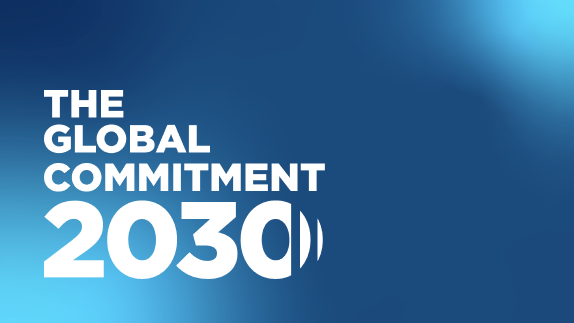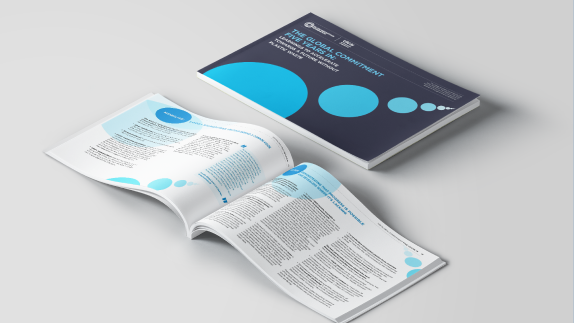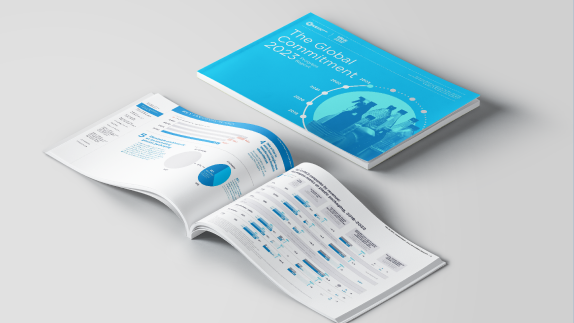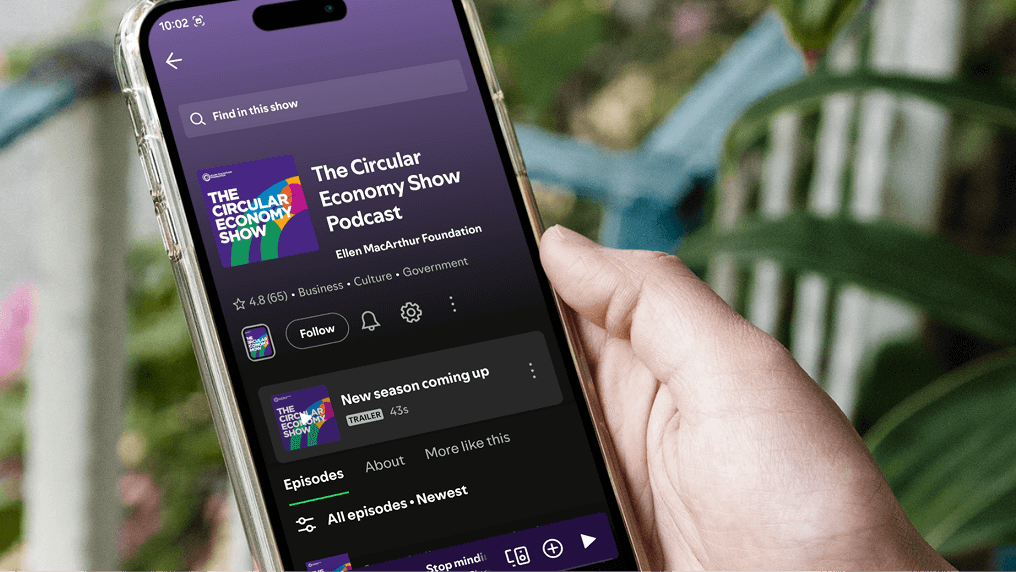In this week's episode, Sander Defruyt reflects on the progress and learnings to date from five years of the Global Commitment, the need for a legally binding global treaty to end plastic pollution, and what makes him feel optimistic about the last five years.
Listen on Spotify, Apple Podcasts, or wherever you get your podcast.
Uselful links:
Transcript
Pippa Shawley 0:04
Hello and welcome to the Circular Economy Show Podcast. I'm Pippa Shawley. In 2016, an analysis by the Ellen MacArthur Foundation found that there could be more plastic than fish in the ocean by 2050. Two years later, in 2018, the Foundation launched the Global Commitment, conceived with the UN Environment Programme, to form the biggest global voluntary effort to tackle plastic waste and pollution. Half a decade on from that launch, we're publishing a new paper reflecting on what has been learned since then. I sat down with Sander Defruyt, who leads the Foundation's plastics team to explore the papers findings. We discuss the impact of this voluntary action, the hurdles that still need to be overcome, the need for a legally binding global treaty to end plastic pollution, and what makes him feel optimistic five years in. I started by asking Sander about the scale of the problem today.
Sander Defruyt 1:03
Today's plastics economy is very wasteful and polluting , and beneath that it's a very linear plastic system. A take, make and waste system, where we take resources, the vast majority of that fossil resources; we make plastics, most often for single use; and then we waste it at the end. And the numbers on that are quite staggering. If we look at plastic packaging as one example, almost all of it is single use. The percent of reusable plastic packaging is probably 1% to 2% max. It's estimated that just 14% of that plastic packaging is actually collected for recycling while a staggering 1/3 is ending up in the environment. And more than half is landfilled are incinerated. And as a result, plastic pollution is everywhere. And it's posing a threat to our... to nature, to climate change, as well as to our human health.
Pippa Shawley 1:59
And so recycling must be part of that, right. So the collection of it and making sure it doesn't just end up in landfill or incineration. But circular economy goes beyond that. Can you talk a little bit about that?
Sander Defruyt 2:12
Yeah, it absolutely goes beyond recycling. So recycling is one part of the circular economy solution. But it's actually only the solution of last resort. It's absolutely crucial that we start by eliminating the plastics that we don't need. That is, avoiding the unnecessary plastics and packaging. But it goes far beyond that, in terms of rethinking the packaging altogether, rethinking even the product itself or the business model. And a few examples of that are, what if cucumbers are not packed with a plastic packaging, but with an edible coating? Or what if we shift from liquid shampoo to a solid shampoo and drastically reduced the amount of packaging needed to get that to the customers or end users? Or what if homecare products come in a concentrated form little tablets that you pop in a bottle, add some water at home and you have your same home cleaning product? All of that would drastically reduce the amount of packaging we need. So start with eliminate. Secondly is innovating the packaging that we do need, and designing it reusable as much as possible. And in any case, always recyclable or compostable. And then finally is circulating. So actually circular, (it's) ensuring that the packaging we put on the market is actually reused, recycled or composted in practice, so keeping it in the economy and out of the environment. So that whole comprehensive solution is needed. And recycling is just one part of that solution. We'll obviously not recycle our way out of this. And recycling alone is not the solution.
Pippa Shawley 3:49
And you've talked a lot about packaging there. What about plastics beyond that?
Sander Defruyt 3:54
Yeah, our focus is is on is on packaging. But obviously plastics is used in many more applications, from toys to building, construction industry, to cars to the clothing we wear. So all... our entire global economy is predominantly a linear economy and quite wasteful. So we definitely need to shift to a circular economy for our entire economy, not just for packaging. But for my work that I'm leading here at the Foundation, that focuses really on packaging.
Pippa Shawley 4:30
And it feels like you've been very busy recently. I mean, I know looking at your calendar, your back to back. But today we're talking about particularly the Global Commitment. It's been five years since that launch, so maybe you can start by telling us a little bit about what that is and what what the goals of that were.
Sander Defruyt 4:46
You had a Global Commitment is the world's largest voluntary efforts to tackle plastic waste. It was conceived by the Ellen MacArthur Foundation together with the UN Environment Programme back in 2018. And we really want to bring together key stakeholders as an early attempt at a globally coordinated response to the problem. It's important to position the global commitment in that kind of context of where we were in 2018, when there was very limited and at best fragmented action on the topic. There was action, (but) absolutely not a shared vision of where to go across all the stakeholders. So launching the global commitment really marked a moment where we brought together a group of leading stakeholders, from business, from governments, from NGOs, to all get behind a common vision. And as such, try and start to lay critical foundations that we hope to evolve to a much more broad system change beyond that leading group. So that's what it did set out to do five years ago.
Pippa Shawley 5:55
And when you talk about the action, what kind of things do you mean?
Sander Defruyt 5:59
So the signatories of the Global Commitment have... all got behind the vision, which has a few different aspects to it. And to bring that to life, we've also translated that in concrete 20-25 commitments that are targets that the signatories are working towards. And those targets range from eliminating some of the most problematic and packaging items, materials and formats. Starting to take action to move more from single us to reuse, making sure all packaging put on the market is reusable, recyclable or compostable, increasing the use of recycled plastics instead of getting new virgin plastic materials. And also reducing the use of virgin plastics as vivid as an outcome of all the actions mentioned above.
Pippa Shawley 6:52
And so it's been going for five years. I mean, just looking around supermarkets and other places, plastic is still there. So how is it going? What have you seen? What have you learned along the way?
Sander Defruyt 7:04
Yeah, and I'll probably answer that question in two parts, and one is looking at the global commitment, specifically, and how is the first five years of that been. What has been the impact? And then secondly, zoom out a bit and look at the world as a whole. And where are we solving that that problem and if I look at the global commitment, I think it has had an immense impact across four different dimensions, from mobilising leading stakeholders to delivering progress to learning along the way, and catalysing action beyond the global commitment itself. If I take these one by one in terms of mobilising leading stakeholders, is a bit what we mentioned earlier, where we started in 2018. From fragmented action, no common vision, no common language, virtually no company with a comprehensive set of targets to address the problem, to now more than 1000 organisations all sharing one vision, the same definitions behind it, all working towards the same set of 2025 targets, and having mobilised dedicated teams, and more than $10 billion of investments towards achieving that. So it has mobilised a lot within the signatory group. When we look at delivering actual progress. Here, the picture is fairly nuanced. On the one hand, we know and we've been transparently reporting every year so we now know that the signatories are not on track to meet all the 2025 targets that they were aiming for. At the same time, if we compare the signatory group to the rest of the industry, the rest of the global plastic packaging markets, the signatory group is significantly outperforming the rest of the market on almost all target areas. Just to give a few examples, they more than doubled their use of recycled content from around 5% to around 12%, on track to more than tripled that by 2025. And that while the world as a whole has increased in their recycled content by just 1% each point. And just to add one factor to show the scale of that, so that the increase of recycled content by the signatory group is equivalent to keeping one barrel of oil in the ground every two seconds. So that's 30 barrels every minute or 15 million barrels every year. They've also stabilised their use of virgin plastic. And that's compared to the market growing their use of virgin plastic with 11% over that same five year time period. If you compare these two, it's means that the group has avoided 2.8 million tonnes of virgin plastics per year, that's equivalent of the total plastic packaging use of the UK in an entire year. This group has has delivered meaningful progress while not as much as they originally intended, so not fully meeting the 2025 targets. Next to mobilising and delivering, learning along the way, was a critical one. In 2018, many signatories took a bit of a leap of faith signing up to the Global Commitment, because many of them didn't have the data or the visibility, even internally in their organisations on how much plastic packaging they were putting on the market, let alone how much was reusable, how much was recyclable, there wasn't even a common definition of what recyclable really meant, or how much was recycled content, etc. That's versus today, where all the signatories are annually and publicly reporting their progress, all using the same metrics, same definitions, making this fully transparent. And that transparency helps them make better decisions, but also creates... in a way is also used by NGOs, policymakers, investors, to engage with these businesses to inform their own actions. And then finally, that transparency has also helped us do now five years in... really shed the light on what are the areas where strong progress has been made, and where it's demonstrated it is possible? And what are the areas where progress is lacking? So it has helped us identify some pivotal hurdles that we see, even this leading group is struggling with and is hindering progress. And then finally, after mobilising, delivering progress, learning along the way, also catalysing action beyond the global commitment group has been a very important part of what the global commitment has delivered. Like from the start, we knew bringing together a leading group is a great start, but we need the whole system to change not just this leading group, and therefore catalysing, you know, by mobilising this leading group also catalysing action beyond that was was a very important ambition of the Global Commitment. And I think, on this front, it has been really successful if you just look at beyond the Ellen MacArthur Foundation and UN Environment Programme, who launched the Global Commitment, also, many of the major other initiatives in this space, from WWF, the World Economic Forum to Consumer Goods Forum to wrap to systemic. They've all endorsed the Global Commitment, vision and having all these major initiatives, sharing one vision is really powerful. Then we've mobilised more than 11 plastic bag. So there's our country level initiatives around the world that don't... again share that same common vision and work towards targets that are very aligned to the Global Commitment targets. The framework, the vision, the definitions of the global commitment has been picked up by UN principles for responsible investments, or UNPRI, for their investment... investor engagement guides. There is a tourism plastic initiative built on the framework of the Global Commitment. There is a Consumer Goods Forum, Plastic Waste Coalition of Action, again, working towards the framework and the vision of the of the Global Commitment. And then there's the CDP reporting. So that's one of the world's largest environmental disclosure systems, they are now expanding their disclosure of company progress to plastics, and again, using the global commitments and reporting and definitions as the basis of that, that allows us to expand this reporting from few hundreds to multiple 1000s of businesses reporting their progress, and it has informed policy. So that's progress, the Global Commitment can can be proud about. But at the same time, and here, we come to zooming out from the Global Commitment to the world. At the same time, it's equally important to recognise that the world as a whole is still far off track of solving this problem. 20% of the market signing up to the Global Commitment is a really big amount. This is very large in terms of scale, but at the same time means 80% is not signed up. And we've just seen that that group is on average performing way worse than this signatory group. On top of that the signatory group itself is not fully delivering on the 2025 targets and struggling with Pivotal hurdles. So if you take that all together, the world as a whole is is still far off track of solving this problem. And so we need to take the learnings of these five years to to inform the next steps and accelerate progress.
Pippa Shawley 14:33
So while some progress has been made through the global commitment, the project has also uncovered a number of hurdles that need to be overcome in order to make further progress. I asked sander to expand on what those challenges are.
Sander Defruyt 14:45
So what we've seen is that there are certain areas eliminating problematic items, increasing recycled content, etc, where the signatory group has made significant progress and as such have demonstrated that it is possible. So there we call on other businesses to replicate that, and follow that example and call on policymakers to kind of mandate that progress that is demonstrated that is possible at very large scale. But then there's also areas where progress is lacking and where we've identified the pivotal hurdles. And the three most important ones we've identified at this stage are scaling reuse, addressing the issue of less flexible plastic packaging, and in particular, in high leakage markets, where they're ending up in the environment, and the lack of infrastructure to collect and circulate these packaging in the economy and keep them out of the environment. So if I take them one by one, like scaling reuse, we've seen, our signatories take more action than ever before. In 2018, reuse wasn't even really part of, of the strategy for most companies wasn't very high on the agenda. Over the past years, the momentum has increased exponentially. And many signatories, more than half of them have launched all kinds of reuse pilots. But when we look at the actual at scale impact, the share of plastic packaging that's reusable, has remained roughly flat below 2% of all plastic packaging. So really scaling reuse, bringing that to scale is one of those pivotal hurdles.
Pippa Shawley 14:46
So going beyond the pilots...
Sander Defruyt 16:30
Exactly, yeah, we at some point, you know, these pilots are great, and where we need to continue investing, need to continue to learn and at some point, if we want to solve this problem, it needs to lead to scale. Because without scaling, reuse, we won't really solve this problem, we can't do it with recycling alone. So this will have to be an important part of the solution. The second one is flexible plastic packaging, and the little wrapper sachets, like the cookie wrappers, all of that small flimsy stuff. They are the fastest growing segment of the plastic packaging market, because they are very... kind of resource efficient, lightweight. But they're also... because of these same properties actually very hard to deal with after they've been used. And in particular, in markets where there is no formal collection systems to collect packaging after use, because they're so small and have like very little intrinsic material value. Also, the informal waste pickers are not interested in picking them up, because then they don't have any economic value to them. So they represent a disproportionate share of all the plastic packaging ending up in the environment. And to give you a sense of the scale, every second 25,000 flexible packaging items are ending up in the ocean. And at the current growth rates, that number will double by 2040. And if you look at that whole time period from now to 2040, that would mean a staggering 20 trillion flexible packaging items would end up in the ocean. So that problem absolutely needs to be addressed urgently in order to solve this problem. And then finally, the third one is the infrastructure to collect and circulate packaging after use. While the solution absolutely needs to start upstream, we need to reduce the amount of packaging we put on the market, needs to make sure everything we do put on the market is as much as possible reusable, is designed recyclable. But then at some point, there also needs to be infrastructure to actually collect and reuse and recycle them in practice after they've been used. And we know in many parts of the world that infrastructure is still lacking. One of the main reasons but not not the only reason but one of the main reasons that the economics don't stack up the cost of collecting, sorting and recycling packaging is just higher than the value you get out in the end. So we know that you need funding to go into the system to make the economics work. And we also know it's widely recognised by many stakeholders around the world, that extended producer responsibility policies, so policies where the company is putting the packaging on the market are also paying for collecting, sorting, and reusing recycling them after after us, that that's the only that policy is the only way to really get that funding mobilised and to make the economics work. So we urgently need to see that policy implemented all across the world. It is already there in some parts of the world. And it is increasing more and more, but we really need to accelerate that and need to see the whole world adopt those EPR policies in order to get that infrastructure established.
Pippa Shawley 19:55
So you've outlined the learnings from the global commitment so far and some of those hurdles that you've got to overcome. How do you do that? What comes next?
Sander Defruyt 20:07
Well, I think there's a few things. I mean, it's very clear that voluntary action can be very impactful, the global commitment has shown it has had an impact in in many ways. So we need to continue to accelerate that. And we need to significantly accelerate policy action, because it's equally clear that we're at present, not stepping up voluntarily, where even those leading players not fully meeting their targets will meet policy to, on the one hand, mandate, the progress that's proven possible, on the other hand, really focus on those pivotal hurdles to try and overcome these and help the market move faster. And further. And there's a few things here in one is, of course, the global treaty negotiations next, next month, or in or into, you know, in a few weeks from now, the third of five plan negotiation rounds of such a treaty is starting. So we're getting into the final year, the final stretch of negotiations. So we absolutely need negotiators of all the countries around the world to understand that this is a very unique once in a generation opportunity and need to, you know, building on some of these learnings from the global commitment and other learnings out there, to really put in place some globally binding rules and measures that can massively accelerate progress. So that's a really big opportunity we have there.
Pippa Shawley 21:37
And what do these rules look like that you're that we're calling on?
Sander Defruyt 21:42
Yeah, I think we, first of all, we want them to be globally binding rules. And you could look at this plastic treaty as the equivalent of what the Paris Agreement is for climate change. They're negotiating a similar agreement on plastics. And we want this agreement to kind of look structurally different from the from the Paris Agreement in the sense that there, the main element is, all countries in the day agree on the kind of overall ambition of one and a half degree temperature rise. But then it's really leaving a lot of freedom up to all the countries to submit their action plans, without even any guarantee that all those action plans actually add up to the overall ambition. We want this treaty to go further and have legally binding rules that really say these are rules. These are things measures actions that all governments that are signing this agreement or treaty need to implement. And the ones we want to see are obviously starting with upstream measures looking at how can we reduce the amount of virgin plastic produced? How can we have reuse policies in place that help stimulate reuse help overcome the pivotal, Pivotal hurdle of reuse that we just talked about? How can we eliminate some of the most problematic items, or leading signatories or leading businesses here have shown that can be done? So how can we get the whole world to do it? Same on recycled content? How do we get the whole world to follow that lead? And then the extended producer responsibility policy that we talked about before as well? How do we get that policy to be adopted globally? So these are a few things that we believe are well suited to turn into global measures and global rules as part of such a treaty?
Pippa Shawley 23:33
And what else? What else is coming up? You've talked a lot about reuse there as well.
Sander Defruyt 23:39
Yeah, so policy very important. Equally, there will always remain a role for voluntary action. This is a complex system change problem, you can turn the entire solution into a policy or into a set of policies. Also, because for some of these pivotal hurdles, not all the solutions are necessary out there. So businesses actually will continue to be important to keep demonstrating what's possible to keep innovating and finding new solutions. So also from our sides, we will take the lessons from five years of Global Commitment, both the successes and the shortcomings, to now inform the future of the Global Commitment, as voluntary action will remain very important. We also want the Global Commitment and the leverage of that platform to keep driving that, but the context is now very different than 2018. We have all these learnings from these five years. So we need to think carefully about how do we design the next phase of the Global Commitment and therefore we're currently starting a process together with our signatories to work that out and see how do we design the future of the Global Commitment in order to further accelerate also the voluntary action and do that in a way that's complementary to that global treaty that's informing that global treaty. So that's, here are some of the key priorities for, for us.
Pippa Shawley 25:06
And it's a huge challenge and one that you've been involved in for several years now. And you've definitely set out the need for this to happen. I wonder what makes you optimistic about this change?
Sander Defruyt 25:24
It's always a tricky one. And I guess there's always if you take the perspective of looking back, it's always fantastic to see how the amount of action and progress that we're seeing now is literally an order of magnitude bigger than what we saw 5-10 years ago. At the same time, if you take the other perspective, and compare that with the scale of the problem, that scale of the problem is is another one or two orders of magnitude bigger than the solutions we've delivered to date. So, you know, that first perspective leads to kind of optimism. That second perspective is a little daunting, but we have no other option than to just keep working and pushing as hard as we can, because we know the scale of the problem is still far beyond where we are today. So yeah, we need to keep working as hard as we can. And some of these unique opportunities, like Global Treaty negotiations, generally, generally hope we will capture that opportunity, or the negotiators in the treaty will capture that opportunity, as that could be one of these moments where you can actually change gears and in a short amount of time, lead to another significant acceleration of progress.
Pippa Shawley 26:48
And just remind us of the timescale that we're talking about here to get these changes, a reality.
Sander Defruyt 26:55
So for the treaty, the negotiators have set out an ambitious timeline of negotiating a treaty in in two and a half years. So they're having one negotiation round every six months. Now in November, they will be having the third negotiation round taking place in Nairobi this time. So that's the third out of five. So they're kind of halfway the negotiations. When I say ambitious timeline, I mean two and a half years for negotiating and global agreements is actually very short, if you compare that to other big environmental problems, like climate change, etc, it took over a decade to get there. So in that sense, it's insured, of course, we have a major problem to solve, we don't have time to waste. So I do hope that they stick to that timeline, particularly for priority sectors, like packaging, and other sectors that are... have a high likelihood of leaking in the environment or have a high rate of leakage in the environment, that they tackle these as a priority within the next year within the first two and a half years. So one more year to go for those negotiations. And hopefully by then we come out with a with an ambitious treaty with a few very concrete, globally binding rules and measures in there.
Pippa Shawley 28:17
So to sum up, we need more ambitious policies, with the Global Treaty being a key part of that. And this should be complemented by continuing to accelerate voluntary action. That means replicating and mandating the progress that's been proven possible over the last five years. But it also means focusing on those pivotal hurdles Sander mentioned, scaling, reuse, addressing flexible plastic packaging, and establishing infrastructure to collect and circulate packaging after it's been used. If you'd like to hear more about the Ellen MacArthur Foundation's work in plastics or read the new paper reflecting on five years of the global commitment, you can find the links in the show notes of this episode. Thanks to Sander for joining me and thank you for listening. We'll be back soon with more stories from the circular economy. See you then.







